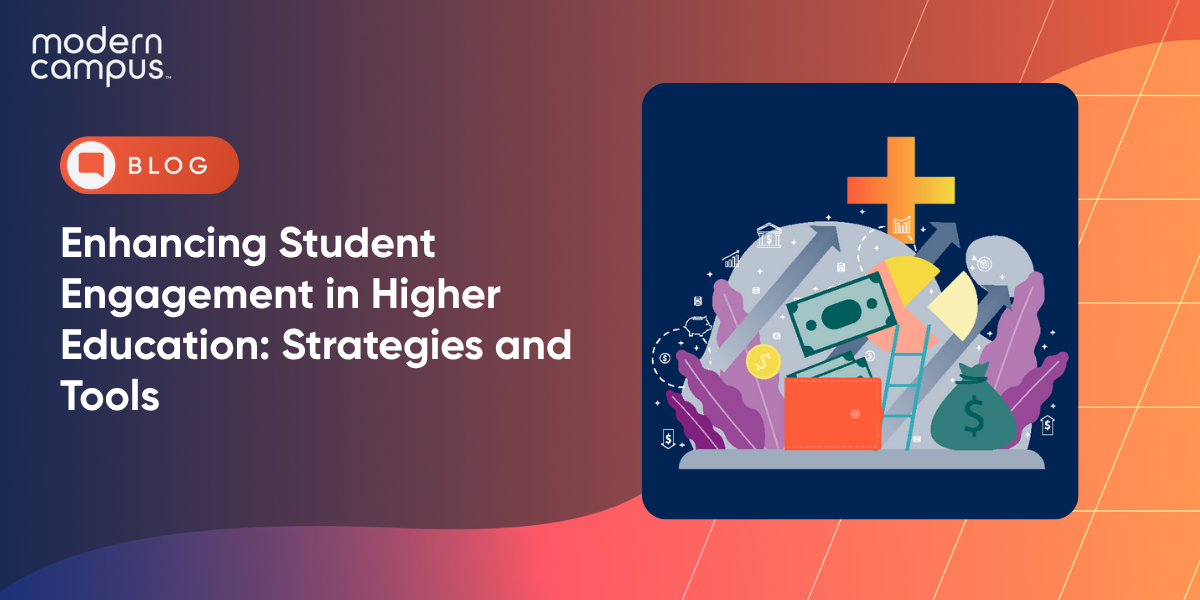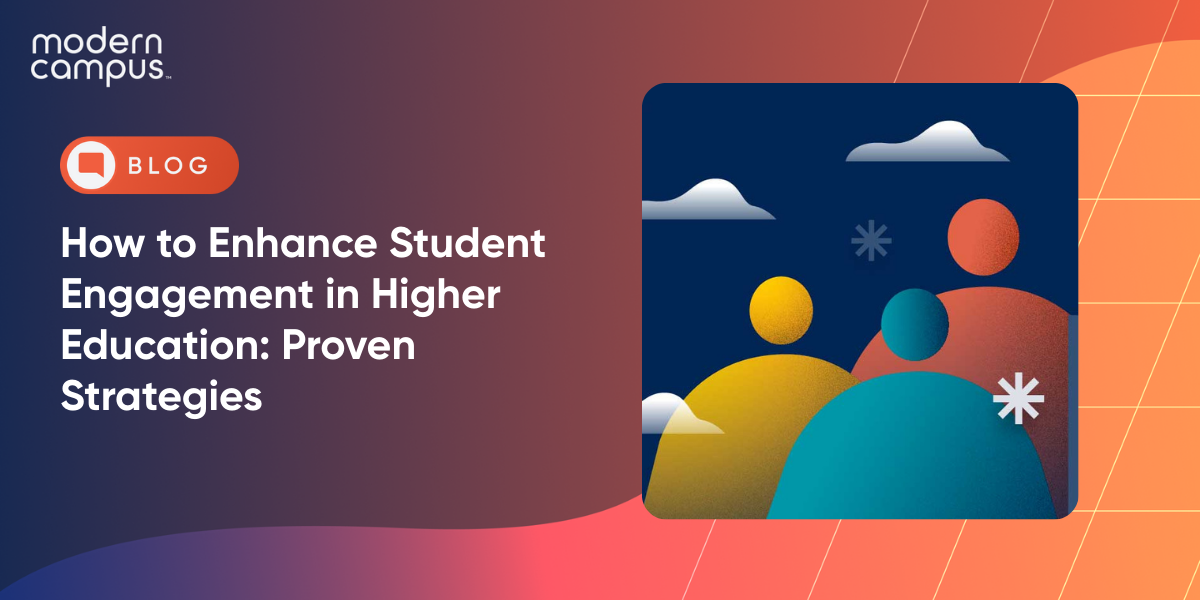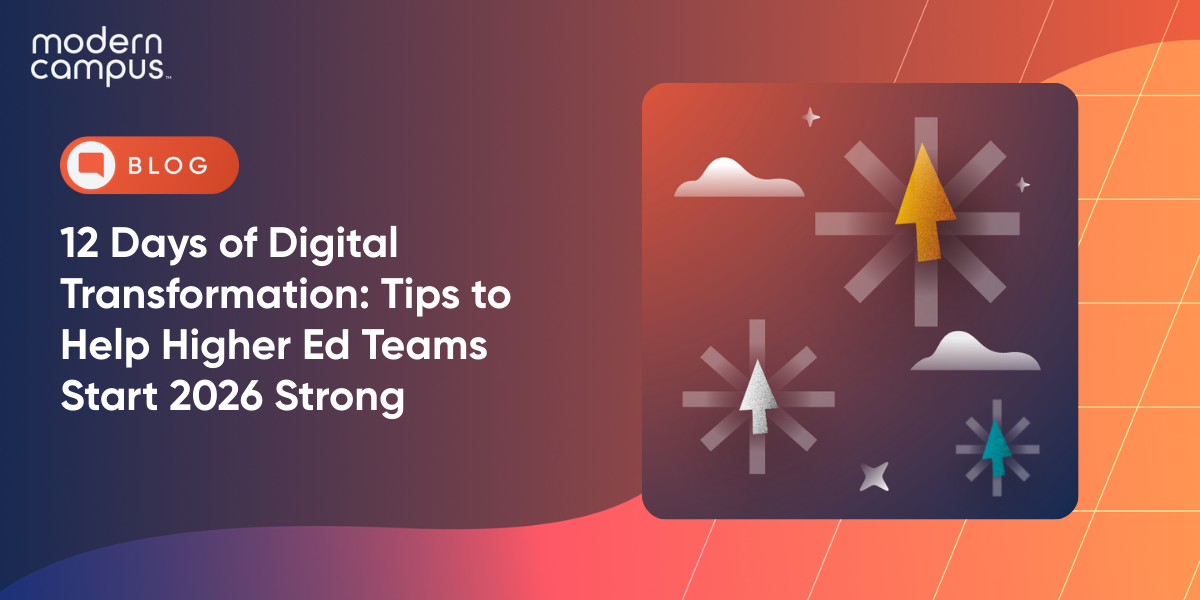Enhancing Student Engagement in Higher Education: Strategies and Tools
Student engagement is a critical factor in institutional success. According to recent research from the National Student Clearinghouse Research Center, institutions that prioritize robust student engagement strategies have seen higher persistence rates in the last decade.
The expectations of modern learners have shifted, with nearly 70% of prospective students expecting personalized experiences from higher education websites. Implementing an effective student engagement platform is essential for institutions aiming to attract, engage and retain learners throughout their academic journey and beyond. Students view themselves as discerning consumers, and their satisfaction hinges on achieving specific outcomes that connect their education directly to career success.
By creating meaningful engagement opportunities that resonate with these expectations, institutions can improve retention rates and foster lifelong relationships with alumni.
Student Engagement Platforms: The Foundation for Connected Campus Experiences
Creating a connected campus experience requires robust digital tools that meet students where they are. Student engagement platforms serve as the technological backbone for meaningful interactions across the entire learner journey.
Key Features of Effective Student Engagement Solutions
A comprehensive student engagement platform should seamlessly integrate multiple aspects of the student experience, from discovering campus activities to tracking participation and measuring outcomes.
The most effective solutions enable students to easily find and engage in campus activities, co-curricular experiences and digital opportunities tailored to their interests and career goals. The primary focus is personalization, as students who participate in campus activities are more likely to persist to graduation.
Advanced engagement platforms also facilitate the development of essential skills outside the classroom. By tracking participation in events, leadership opportunities and campus organizations, these platforms help students build portfolios of experiences that complement their academic achievements. This holistic approach to skill development allows institutions to measure not just attendance at events but also the acquisition of valuable competencies that employers seek.
The data shows that students who can connect their co-curricular activities to specific career-relevant skills are better positioned to articulate their value to potential employers after graduation. Institutions that align with students' goals are more likely to see improvements in student engagement and retention.

Measuring Impact: Analytics and Insights to Drive Decision-Making
The true power of modern engagement platforms lies in their analytics capabilities. Data-driven insights enable administrators to identify which programs resonate with students and which might need adjustment. By tracking metrics such as attendance patterns, demographic participation and program popularity, institutions can make informed decisions about resource allocation and program development.
Robust analytics allow for early identification of at-risk students. By monitoring student engagement and retention levels across various populations, institutions can identify those who may be disconnected from campus life, often a precursor to academic struggles or withdrawal.
According to research, nearly 24% of students drop out after their first year. With engagement tracking tools, administrators can identify under-engaged students using built-in analytics and demographic data, enabling proactive intervention. This approach allows institutions to deploy targeted outreach strategies, connecting disengaged students with relevant opportunities and support services before they make the decision to leave.
Personalized intervention strategies directly address the concerning statistic that 37.8% of higher education students fail to earn a credential within six years, potentially saving institutions the estimated $100,000 in lost tuition, fees and potential earnings associated with each non-graduating student.
Adopting a proactive approach transforms engagement from a nice-to-have into a powerful retention tool that directly impacts an institution's bottom line.
Beyond Technology: Creating Meaningful Engagement Opportunities
While technology provides the framework, meaningful student engagement ultimately depends on the quality of experiences offered. Successful institutions recognize that student engagement and retention strategies must extend beyond digital tools to create authentic connections.
Co-Curricular Activities and Their Role in Student Development
Co-curricular activities serve as a bridge between classroom learning and real-world application. These structured experiences, ranging from student organizations and volunteer opportunities to leadership programs and campus events, provide students with chances to develop essential skills that complement their academic studies. Research from the National Association of Colleges and Employers indicates that employers value teamwork, problem-solving and communication skills. These competencies can be developed through well-designed co-curricular programs.
The most effective co-curricular programs support specific learning outcomes. By aligning activities with competency frameworks and tracking student participation, institutions can help learners build comprehensive portfolios that demonstrate skill development over time.
As students prepare to transition from learners to earners, higher ed must provide them with concrete examples of how their campus involvement prepares them for professional success. Because co-curricular activities can lead to students taking on more credit hours per semester, these programs clearly contribute to academic progress as well as personal development.
Personalized Communication Strategies That Drive Participation
Even the most compelling campus activities will fall short if students aren't aware of them or don't see their relevance. Personalized communication strategies have become essential for connecting students with opportunities that match their interests and goals. The most successful institutions leverage data about student preferences and behaviors to deliver targeted messaging through channels students actually use.
Text messaging is a particularly effective tool for driving engagement, with open rates for SMS messages reaching up to 98% compared to email's average of 20%. By implementing automated yet personalized text messaging systems, institutions can guide students through important processes, remind them of upcoming events and provide timely nudges that keep them on track.
This "right message, right time" approach increases participation rates while reducing the communication burden on staff. When these messages are further personalized based on student interests, academic programs or career goals, engagement rates climb even higher, creating a virtuous cycle where increased participation generates more data, enabling even more precise personalization for future communications.
Success Stories: Transforming Student Experiences Through Engagement
Theories are great in the planning phase, but it's better to see how student engagement and retention strategies play out in real-world scenarios. A powerful student engagement platform can revolutionize how institutions connect with their learners, as demonstrated by these impressive success stories from across higher education.
How Community Colleges Are Tripling Website Engagement
Central Oregon Community College (COCC) faced declining enrollment and needed to transform its online presence to better connect with prospective students. After surveying high school students, they discovered that career information was a top priority. COCC implemented a comprehensive platform to provide accurate, easy-to-understand career data across all their academic program pages.
The results were remarkable. Analytics showed that students spent between one and one-and-a-half minutes on these career pages (compared to the site average of 15–30 seconds), and the pages accounted for 5% of all page views on the site, with 3–9% of visitors clicking through to application pages. This strategic focus on connecting education directly to career outcomes improved website engagement metrics and provided prospective students with the information they needed to make informed decisions about their academic journeys.
Arts Institutions Building Stronger Student Communities
Cornish College of the Arts in Seattle demonstrates how even small institutions can create big impacts with the right student engagement and retention approach. With only 455 students, Cornish's Office of Student Life implemented a modern platform to streamline engagement processes that might otherwise be overlooked due to their small team's many responsibilities.
As Dr. Brittany D. Henderson, Dean of Student Affairs, noted, the college needed an intuitive platform that would not just track event attendance but serve as a comprehensive co-curricular solution that connects students with opportunities while measuring essential skill development.
The platform's success came from its ability to reduce barriers to participation, provide data for decision-making and deepen learning by connecting engagement to real-world skills. Students were able to build portfolios that demonstrate competency development, preparing them for professional success after graduation.

Leadership Development Through Structured Engagement Programs
College of DuPage (COD), Illinois's largest community college, transformed its student leadership development efforts through an integrated engagement strategy. With nearly 90 student organizations and a robust events calendar, COD needed a centralized hub to present opportunities in a way that was "organized, consistent and intuitive" while gathering comprehensive data on student participation.
They implemented an all-in-one student engagement platform called ChapLife, which students can access through any web browser or mobile app. This digital hub has been particularly transformative for COD's Living Leadership Program, a free, non-transcript leadership certificate program that helps students develop confidence and competencies for leadership roles. By housing this program within their engagement platform, COD made leadership development more accessible than ever, allowing the program to be self-paced with participants selecting from a menu of requirements. The result is a more engaged student body with clear pathways to leadership development.
Connecting Engagement to Career Outcomes
Students increasingly demand a clear return on their educational investment. Effective student engagement and retention strategies must extend beyond campus activities to explicitly connect learning experiences with future career success.
Creating Clear Pathways from Classroom to Career
To truly engage students for the long term, institutions must help them visualize their educational journey as a seamless path to meaningful employment. A future-focused solution empowers institutions to guide students toward their ideal careers by connecting learning directly to career outcomes.
This approach addresses a critical pain point in higher education, where 53% of prospective students wonder if college is worth the investment. By implementing structured career pathway tools, institutions can create the learner-to-earner lifecycle, a framework that guides students from initial enrollment through graduation and into successful careers.
The most effective career pathway systems offer personalized guidance based on students' interests and goals. For example, students can choose common personas or objectives that align with their aspirations, helping them quickly find relevant programs and information. Personalization helps students see themselves in their future careers and understand how each course contributes to their professional development.
Institutions using these tools report higher retention rates, as students who can clearly envision their post-graduation success are more motivated to persist through academic challenges. As demonstrated in the Central Oregon Community College case study, when students can easily access information about how programs connect to specific careers, their engagement with institutional websites dramatically increases, a leading indicator of improved retention.
Using Real-Time Labor Market Data to Enhance Relevance
Student engagement and retention efforts are more effective when backed by current, accurate information about employment trends and opportunities. Platforms that integrate real-time labor market data, including salary insights and growth opportunities, enable students to make truly informed decisions about their academic and career goals. This integration of market intelligence addresses a fundamental anxiety for many students: Will my degree lead to a viable career?
The data shows that institutions leveraging real-time labor market information in their student engagement platforms see measurable improvements in student satisfaction and persistence. When students can explore specific salary ranges, job growth projections and skill requirements for careers aligned with their programs of study, they gain confidence in the value of their education. This transparency builds trust and strengthens the student-institution relationship, a key factor in retention.
When faculty and advisors have access to this data, they can better guide students toward high-demand fields and help them develop the specific competencies employers seek. The result is a more relevant, responsive educational experience that engages students by demonstrating clear connections between classroom learning and workplace success.

As institutions face fluctuating enrollment challenges, this data-driven approach to connecting engagement with outcomes represents one of the most promising strategies for enhancing both student engagement and retention.
Build a Student-Centered Engagement Strategy for Long-Term Success
The path to enhanced student engagement and retention is clear: institutions that implement comprehensive strategies powered by the right student engagement platform can create transformative experiences that connect directly to career outcomes. By conducting an honest assessment of your current engagement efforts, leveraging technology to personalize the student journey and measuring the impact of these initiatives, your institution can build meaningful relationships with students that extend far beyond graduation.
The success stories we've explored demonstrate that regardless of size or type, every institution has the potential to dramatically improve engagement metrics and retention rates when they prioritize connecting students with relevant opportunities and career pathways.
At Modern Campus, we understand that enhancing student engagement is about fostering genuine connections that transform the student experience. Our student engagement solutions are built specifically for higher education, with decades of expertise in helping institutions support the entire learner-to-earner lifecycle. We provide the tools and expertise to help you build meaningful relationships with your students that last a lifetime. Connect with us to learn how our solutions can help your institution attract, engage and retain learners for life.
Last updated: May 7, 2025



